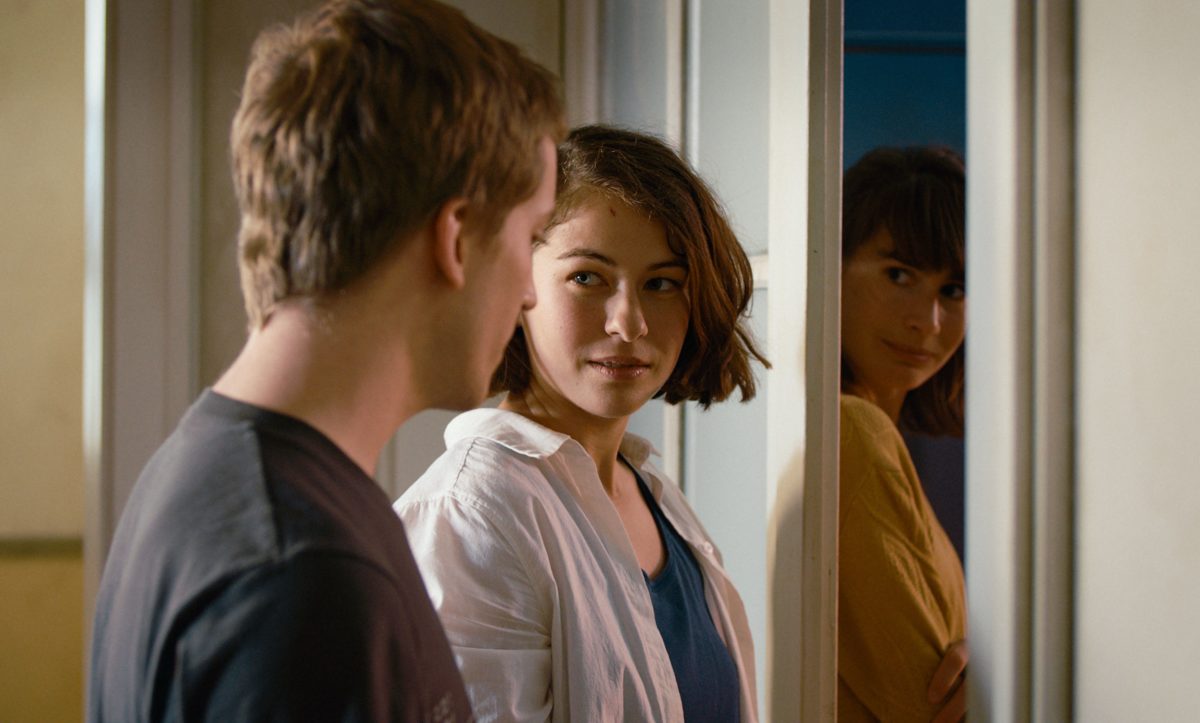The Discreet Insanity of the Bourgeoisie
“… and this room is its coffin”, Mara (Henriette Confurius) fabulizes with a nod to the piano that a former roommate left behind. The sardonic statement is among a multitude of death references which run through Das Mädchen und die Spinne (The Girl and the Spider), Ramon and Silvan Zürcher’s second feature film and, like their first, a chamber play set amid the Central European bourgeoisie: a boy from the neighboring apartment has painted his face white and claims to be a ghost; the camera lingers on the crumpled body of a fly that Mara just killed with one swift gesture; Lisa (Liliane Amuat) lets her well-coiffed mother know that she once composed an unsent email to her containing two death crosses—one accidental, the other intentional, a keyboard shortcut suddenly revealing what had previously been ineffable.
Death is a fitting motif for this film, which could be classified as an antiseptic vampire film: repressed desire finds chilling relief in merciless bloodsucking. These bloodsuckers live between their parents’ antique hand-me-downs and IKEA shelves, filled with mandatory reading from recent student days. They do not share the grandeur and neck-biting violence of their historical predecessors, but equal them in cruelty, even if only one of them displays overtly vampirical traits: Nora (Lea Draeger), who shares an apartment with Kerstin (Dagna Litzenberger-Vinet), where she occupies a perpetually dark room that she hardly leaves before nightfall. There, she obsesses over her desire for the warm skin of an anonymous man at the gym and preys on another, innocent redhead Jan (Flurin Giger).
The lackluster sadism of these characters comes through in small gestures, like pouring hot coffee on the neighbor’s dog, and acerbic comments that accompany casual exchanges and anecdotes. Mara, interpreted by Confurius with tight-lipped aloofness, brings tears to Jan’s eyes by plainly stating that nobody likes him, least of all her. She then crushes a fly to death, “the only one who’s left to like you”, and leaves behind a baffled Jan, whom she met only the day before. Alongside this conversational cruelty, long shots of stares cover a significant duration of the film: a boy from Mara’s and Lisa’s apartment building observes the rattling jack hammer of the construction workers in the street and the crack that slowly creeps into the concrete. Kerstin, the smoking seductress from downstairs, casts longing glances at Markus (Ivan Georgiev), Mara’s and Lisa’s third roommate, only to reject him time and time again. He and Mara in turn watch the woman who works at the pharmacy downstairs, declaring from the elevated vantage point of their airy apartment that she is sorting the shelves “like a robot”. The extended portrait shots of one character observing another create a crisscrossing grid of social control that leaves the viewer with an intensifying feeling of claustrophobia. The choice of objects and clothes—devoid of any patterns, plain and clean in a way that uncannily sits between real and unreal—adds to the impression that there is no love lost, no warmth to spare in this social environment.
A convoluted relief, perhaps even tenderness arises in moments of hurt, such as when Mara tells Lisa to go fuck herself—a sudden outburst that briefly lets backhandedness subside. The honesty in the insult points to a shared history which must be rife with emotional damage, enough to make Lisa move out, not enough to warrant an open address. Tenderness lies in Jan’s teary-eyed response to Mara’s harshness, a rare sign of sadness accompanied by a willingness to bear the painful price of his budding feelings for Mara. The two handymen Jan and Jurek (André M. Hennicke), hired to help with Lisa’s new apartment, are the most likable, vulnerable characters. They are arrivals from the outside, not yet trapped in the caustic net of this particular social constellation, who meet for casual after work beers at a roadside stall and smile with their eyes; quite unlike their temporary employers, who are so intent on sticking to the protocol of good taste and familial politeness that they neither learned to love nor hate, an emotional lack that limits their expressive register to restrained resentment.
The film, whose title could have been drawn from a collection of Grimm’s fairy tales, is a thoroughly chilling portrayal of relationships gone awry; the layers of hurt and disdain that build up between people who once liked each other. This is hardly a new theme and at times the film becomes trapped in the intricate construction of the fable it spins. However, the anti-gothic horror that creeps in between moving boxes and picture frames adds an element of irreality that moves the Zürcher brothers’ film beyond the conventions of the chamber play genre, creating a thoroughly oppressive environment that provokes a visceral reaction. This is not a film to be enjoyed—too tightly woven is the net of everyday insanity that encloses the characters. “Spinnen”, which literally translates to weaving, but is also a common expression for “being insane”, is used several times throughout the film, remarkable because of its proximity to “Spinne,” the German word for spider. “Spinnen” indeed is what most characters in The Girl and the Spider do, entangling each other more and more in the filaments of their maddening grudges.
